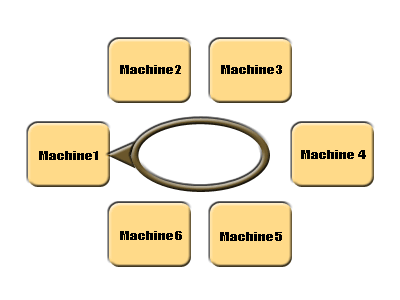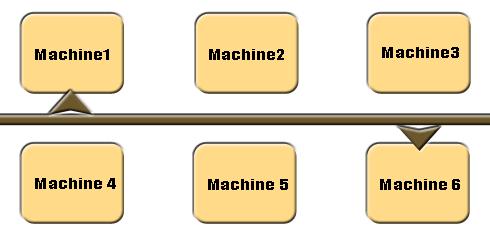


|
|
|

BiographyMaster's workLibraryLinksReport about the searchIndividual taskt-box@inbox.ruDonNTUMaster's portal of DonNTU
|

Tatyana A. KorobkovaFacultyThe Faculty of Computer Information Technologies and AutomaticsSpecialityThe speciality of Automatic System ControllingTheme of master's workDevelopment of the automated subsystem of machine layout optimizationLeader of workPh.D. of Computer Science Aleksandr I. Sekirin::русская версия Abstract
Introduction. The urgency substantiationContinuous scientific and technological progress and the continuous increase in quantity and complexities of products, and also ageing lead to increasing of labouriousness and complexity of constructive and technological works. In most cases FMS are formed on the basis of machine tools with CNC, that substantially promotes introduction of group methods of processing. The purposes and problems
The purpose of the given work is development of the automated subsystem of machine layout optimization of the machine-building enterprise. For achievement of an object in view it is necessary to solve following problems:
The prospective scientific noveltyCreation of the modified genetic algorithm adapted for the decision of a specialized problem of reception close to optimum layout decisions for equipment FMS at a shop level is offered; For reception of the optimum scheme of configuration of the equipment it is supposed to use alongside with genetic algorithm model FMS, for maintenance of calculation of criterion function for the set set of chromosomes. The prospective practical valueOne of the most important factors to consider in designing the manufacturing facilities is finding an effective layout. A general definition of plant layout problem is to find the best arrangement of physical facilities to provide an efficient operation. Layout affects the cost of material handling, time and throughput, and hence affects the overall productivity and efficiency of the plant. Brief review of the task solution existing methodsThe layout of machines normally depends on the type of manufacturing industry. In a case where product volumes are high and variety of products are low, the manufacturing process is known as a flow shop process and the layout is normally based on products. Hence, the layout is called layout by product. On the other extreme, a manufacturing plant may have a high variety of products with low production volume, where the process is known as job shop and the layout known as job shop layout, layout by function, functional layout or layout by process (Dilworth (1996)). Group technology (GT) or cellular manufacturing is normally applied to manufacturing systems that are in between these extremes with the layout known as the cellular layout. Figure 1 shows the type of layouts for different types of manufacturing systems. Another type of product layout is the fixed product layout. In contrast to other types of layout, in the fixed layout the production equipment moves toward the product and not otherwise. This type of layout is common when the products are large in size such as the making of ships or aeroplanes. In cellular manufacturing, the cell layout problem, or sometimes known as the machine layout problem, is basically concerned with finding the best arrangement of machines in each cell. The three major types of arrangement in the GT cells are the single-row, multi-rows or loop layout, as shown in Figures 1 - 3.
Machines can be arranged in a single row, multi-row, or loop layout depending on the sequence of operations. The single row layout may assume different configuration such as semi-circular, linear or U-shaped. The machines in the single row layout are arranged as close as possible to the sequence of operations of all the parts processed in the layout in order to minimise travelling time. In this layout, the sequence of operations are normally similar from one part to another and the material handling equipment used are normally conveyors. The multi-row layout is usually linear and the movements of parts can be between any machines in different rows as well as in the same row, which is suitable for FMS. In the loop layout, machines are arranged in an oval path with unidirectional movement. The conventional technique to find the best layout possible involves the use of diagrams and graphs. A detailed analysis needs to be done on the routing of parts, volume moved, distance, frequency of move, rate of which the part travel and the cost of the move. Some common techniques used are assembly charts which gives the graphical representation of flow of parts, operation process charts, multi-product process charts, string diagrams, and from/to charts, etc. The quantitative approaches on the other hand, are primarily concerned with optimising the location of equipment with the movement of material, and include techniques from the operations research in addition to mathematical techniques. The measure of effectiveness used in the quantitative approach is the distance travelled by the parts. Among the techniques used to solve the layout problems are linear programming, assignment problem, transportation programming, transshipment programming, and integer programming, etc. More recent approaches to solve the layout problem include simulated annealing, and genetic algorithms. Suresh used a genetic approach to solve the facility layout problem, where the objective is to minimize the cost of interaction between various departments. Unlike the machine layout problem, the facility layout problem is more involved in finding the best layout for cells/departments and not finding the arrangement of machines. Planned resultsResults of modelling are important for the machine-building enterprises. The optimum scheme of streams of subjects of work allows to define the optimum structure of flexible manufacture providing a high degree of use of a fixed capital; to find a variant providing the maximal loading of the equipment in conditions of existing structure of manufacture. ConclusionRough in development of mechanical engineering and simultaneous sharp jump in last years have forced to think seriously of new, more precision ways of optimization of work of manufacture. In the given abstract I have tried to explain problems and my master’s works, to make the brief review of problems with multi-objective optimization, to tell about applied methods. The given abstract is not the final version since end of researches on a theme of master's work is planned till 31.12.2006. For final version of the dissertation, please, address to the author. Sources
|
| DonNTU || Master's portal of DonNTU | |





